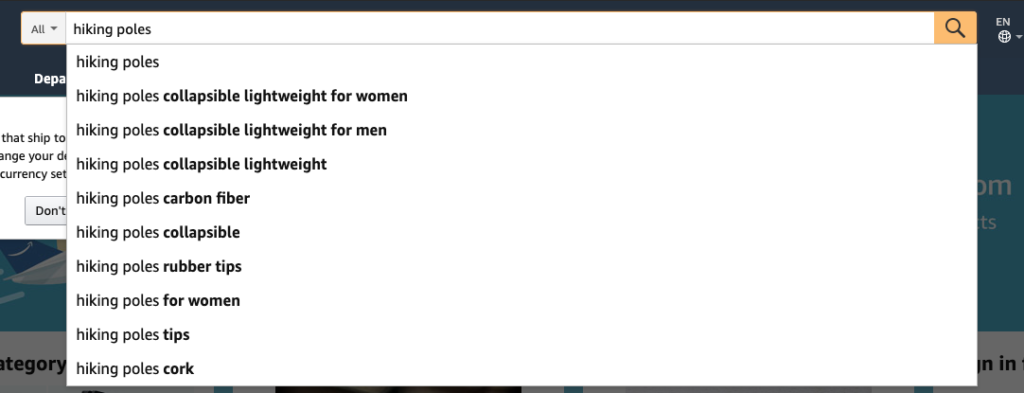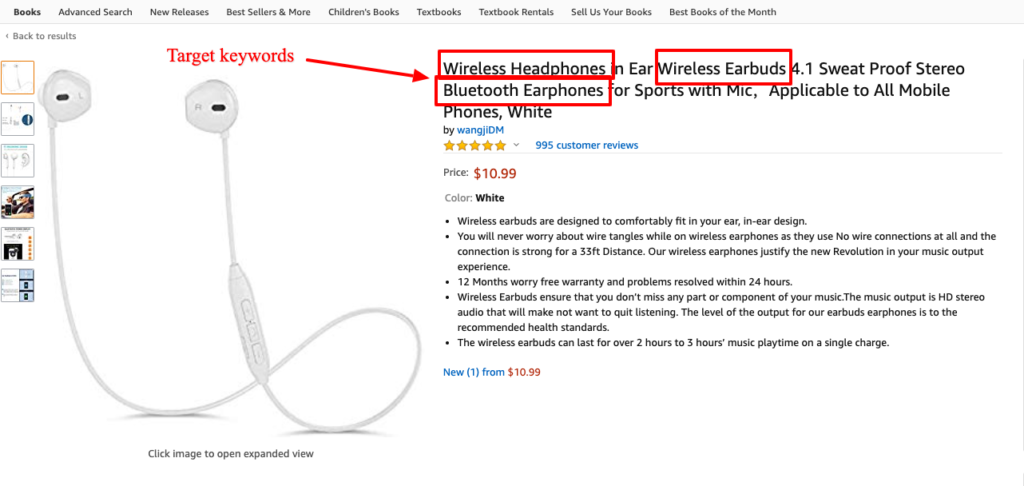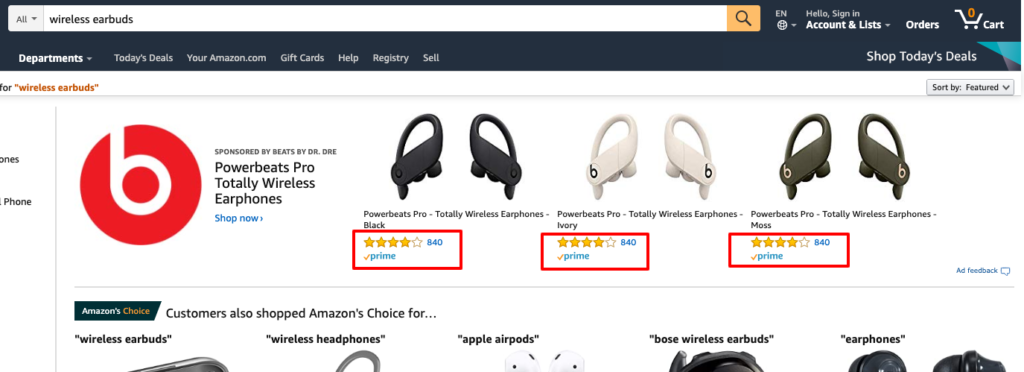OK, let's all just be honest with ourselves for a minute: Most trends reports are nothing more than wishlists and ...

To achieve your ROI goals, you need to target the right Advertising Cost of Sale (ACoS), the key metric Amazon uses to illustrate how your ad spend leads to targeted sales.
Here’s how it’s calculated: ACoS= Ad spend/Sales
Say, over the course of a month, you spend $170 on advertising which generated $680 in revenue. ACoS = 170/680 = 25%.
So, what’s a good ACoS? It really depends on your profit margin. Your profit margin is your profit per unit sold divided by the price. If for example you sell a $100 product on Amazon and it costs $75 to produce, your profit per unit is $25.
Profit per unit / Product price = Profit margin
$25/$100=0.25
Your profit margin is 25%.
So, how high can your advertising cost of sale be in order to break even and eliminate wasted spend from your advertising efforts? In this case, 25%. But of course, you want a profit. So your ACoS needs to be lower. Maybe 10% or 15%. It all depends on your pricing point and business needs.
The good news is there are many changes you can make to improve your ACoS on Amazon. Spending less money on ads is not the only way to lower your ACoS. Here are 9 areas to focus on to optimize your ads and improve performance.
Amazon offers both manual and automatic campaign options. Each strategy has its benefits. With automatic campaigns, you allow Amazon to determine when to display your ad based on keywords identified in the title, description, and other aspects of your listing. Automatic campaigns are easy to set up and can help you identify relevant long-tail keywords to target.
With manual campaigns, you define your target keywords and set your own bid rates. This allows you complete control over strategy and targeting.
If you’re just getting started with Amazon advertising, it’s recommended to begin with automated campaigns then gradually switch to manual. Automated campaigns will help you understand how the system works and hopefully identify some important keywords you should target. Once you do switch to manual, make sure you have a precise campaign structure that improves targeting. Creating relevant ad and keyword groups allows you to better control bidding on different product types to improve ACoS.
Your cost of advertising and ACoS performance ultimately depends on how much you bid on the keyword, ad group, or campaign. As with Google Ads, Amazon will show you the average bids for keywords. Use this as a starting point for setting your bids. In general, you should bid lower on low converting keywords and higher on high converting keywords. If your impressions are too low, consider increasing your bid or referencing the buy box status to ensure your Amazon Standard Identification Numbers (ASINs) are eligible to serve.
Optimizing your bids is really a balancing act. Bidding high improves your product rankings and can drive more clicks, but also potentially increases your ACoS. Bidding low decreases your product rankings and can cause you to lose clicks, or worse, not qualify for the auction at all. The best strategy is to test different bid levels and see how they impact performance.
If you already run campaigns with Google AdWords Shopping, resist the urge to simply copy over keyword lists from Google Ads. Amazon is a completely different platform, where different keywords may be more or less valuable for campaign success.
The best resource for finding relevant keywords to target is Amazon itself. Type a base keyword into Amazon’s search bar and take a look at suggested results to get ideas:

There are also quite a few third-party keyword research tools out there that can help you build keyword lists specifically for Amazon.
Whatever keywords you find, just make sure they best represent the intent of your target audience when looking for your products. Some keywords are more relevant than others, especially for different products and ad types. Look at Sponsored Products, for example. Specific, long-tail keywords are the most relevant to target because you’re showing ads to people who are looking for something specific. With Sponsored Brands, on the other hand, your goal is to build awareness for your brand and its product offerings. In this case, targeting more generalized keywords is most relevant.
Similar to Google and Bing Ads, Amazon allows you to target keywords and specify different match types. Here are the three main match types you can use:
Here’s an example of how match types work:
| Keyword: Hiking boots | Keyword match type: | ||
| Search Terms: | Broad | Phrase | Exact |
| Hiking boots | ✓ | ✓ | ✓ |
| Hiking boots for women | ✓ | ✓ | ? |
| Women’s boots for hiking | ✓ | ? | ? |
| Hiking shoes | ? | ? | ? |
| Women’s boots | ? | ? | ? |
It’s difficult to know which match types will be the most valuable for your campaigns. In general, targeting phrase or exact match keywords can lower your ACoS, because you’re limiting your ad visibility to people who are searching for something very specific. But, leaving out broad match keywords means you miss out on more click opportunities that can lead to sales.
It’s best to create different ad groups for each match type so you can test and see which ones are converting better. You should also look at the search query report on a regular basis. These search terms indicate what queries are currently triggering your ads. You may want to add any converting search terms as exact match keywords to generate more conversions. You should also add irrelevant queries as negative keywords.
As with Google Ads, you can add negative keywords to your Amazon campaigns. Negative keywords are irrelevant keywords that you don’t want your ads showing for. Say, for example, you sell beard grooming and trimming kits and want to target the keyword “shave kit.” You can add “shave kit for women” as a negative keyword because the keyword is irrelevant to your product.
To get some ideas of negative keywords to add, you can download Amazon’s Search Term Report. This is a report of all the search terms people use to find your ads. Go through the terms and see if there are any queries that are misleading or irrelevant to your product.
Some businesses like to include brand keywords as negative keywords in their campaigns. If someone’s using your brand name in their search query, they are much more likely to click on your product from organic results anyway. Showing an ad would just encourage them to click on your sponsored product, wasting your ad spend.
That said, some advertisers like to target brand keywords because they have a high conversion rate. You can test out the value of targeting or eliminating brand keywords by creating a separate campaign and monitoring performance.
In January 2019, Amazon rolled out bid adjustment features similar to Google Ads. You can adjust your bids manually, or use dynamic bids to adjust bids up or down.
Automated options use machine learning to determine the likelihood an ad click will convert, then adjust bids accordingly. You can allow dynamic bids to adjust up and down, or down only. Amazon also allows advertisers to set placement bid adjustments to reach the top of the search page or product page placements. You can set up to a 900% increase.
Bid adjustments are a powerful tool that can help you prioritize targeting certain ad positions that are likely to convert. You can always create a test campaign to try out different bidding strategies and monitor results.
Succeeding with Amazon advertising isn’t just about targeting the right keywords and setting the right bids. Your product listing itself needs to be optimized to get visibility. Amazon uses a search algorithm known as the A9 algorithm to rank products in search results. Even if you’re promoting a product, Amazon still has to consider its relevance for a specific search query when ranking your ad.
That’s just one reason why it’s important to optimize your product listings. After clicking on your ad, consumers are also much more likely to convert if they land on a highly optimized product page. Optimizing your product listings can improve ad rank, clickthrough rate, and conversions.
Here are some important factors to consider when optimizing your Amazon product listing:
Keyword Placement
It’s very important to include target keywords in both your product name and description. This shows both Amazon and shoppers that your product is relevant to what they’re looking for. Of course, you’re likely targeting many keywords for the same product. Prioritize the most valuable (high converting) keywords and put them at the beginning of your product title. You can include other relevant keywords at the end of the title and in the description.

Images
Include high-quality images that illustrate the value of your product. The primary image should have a white background. Additional images can show different sides of the product, different varieties, or use cases. Use all 7 image slots. Optionally, the last image slot can include a video of the product.
Bullet Points / Description
The bullet points section is an important place to illustrate the value of your product. Focus on features that matter to your target audience the most. In the description, you can go into more detail about specifications and include more relevant keywords as well.
Product reviews are probably the most important factor shoppers consider when making a purchase decision. But they also have a huge impact on whether or not someone clicks on your ad. Product title and reviews are the most prominent aspects of an ad:

It doesn’t matter how well you target your keywords or how high you bid on placement, your products won’t get clicks if they don’t have positive reviews.
So, as part of your marketing efforts, encourage your audience to leave reviews for your products. You can do this easily by emailing your current customers, asking them to review their past purchases. Of course, even the best products will get some negative reviews, but you can mitigate their impact by addressing customer concerns. Try to make dissatisfied customers happy so they will remove their negative reviews. If someone has left your product a negative review and it seems unfair, then you can also request Amazon to remove it. Having a high number of positive reviews for your product can improve click-through rates on your ads and reduce necessary ad spend to drive results.
ACoS is an important performance metric, but it isn’t the only thing you should be paying attention to. Other important campaign metrics include:
These metrics can tell you a lot about which areas of your advertising campaign need improvement. Look at the click-through rate, for example. If you have a very low CTR, then it’s likely there’s something wrong with your targeting. Maybe your ad is showing up for irrelevant keywords. Experiment with narrowing down your keyword lists to see if CTR improves.
Whenever you want to make major changes to your ad, ad groups, or targeting, it’s easy enough to set up a new campaign. Then you can test these changes and see if they have the desired impact on key performance metrics.
Investment in Amazon advertising is growing exponentially. If the trajectory continues, it could become more popular than Google Shopping for eCommerce sellers. If you want to get the most value out of your investment in the long run, now’s the time to start investing in performance marketing tactics for Amazon advertising.